The Essential List 06. Veronica Valentine’s Favorite Jewelry
The jewelry and gemstone specialist shares vintage pieces from her collection, an easy jewelry cleaner, and tips for navigating the world of secondhand jewelry.
Today, I’m excited to talk to NYC-based jewelry and gemstone specialist Veronica Valentine (yes, it’s her real name and, yes, it’s so cool). Her newsletter
offers a fascinating peek behind the industry curtain, which I personally know so little about, so I was very excited to connect, pick her brain, and learn more.We chat about her experiences in estate jewelry and gemstone manufacturing, how to understand the price of secondhand jewelry, her favorite places to find new pieces, and some thoughts on the lab-grown diamond trend. But first, she's sharing some favorites from her personal collection.

Vintage Tiffany & Co Angela Cummings ‘Positive and Negative’ Earrings A rare find. These were created back in the early 1970s by Angela Cummings for Tiffany & Co. They are such a conversation starter! The positive and negative patterns, one of her most iconic designs, feature black jade (stone) inlay rather than enamel over gold, which is truly remarkable.
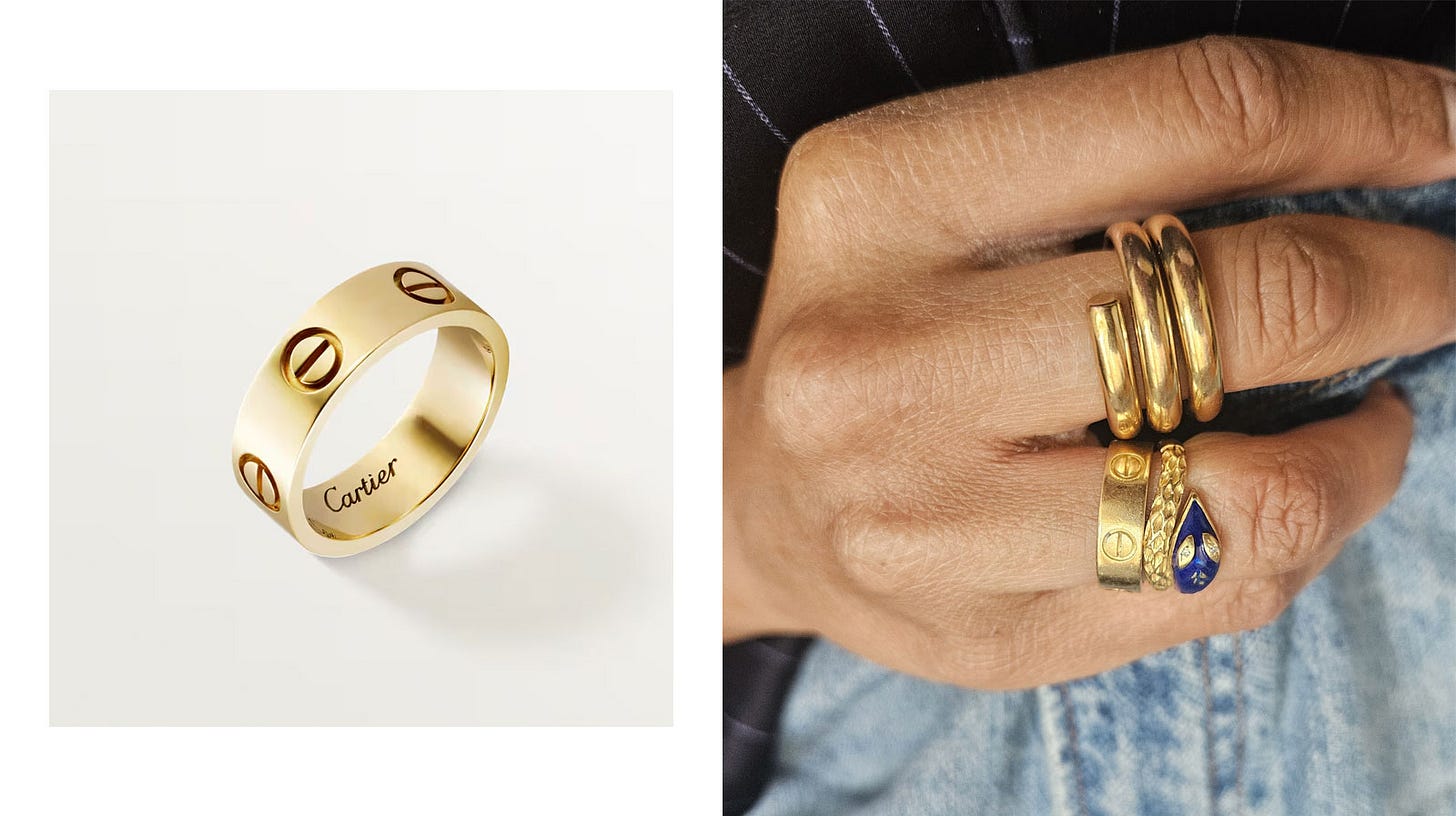
Vintage Cartier ‘Love’ Ring I’m not particularly fond of the Cartier ‘Love’ machine or similar mass-produced jewelry from big, commercial houses. However, this ring, which I wear on my right ring finger is an exception. It’s a vintage piece from the 1990s that I bought second-hand during my first job in jewelry nearly 15 years ago! It’s become a foundational piece for stacking and serves as a reminder of where I came from—how excited and proud I was to have bought this ring for myself.
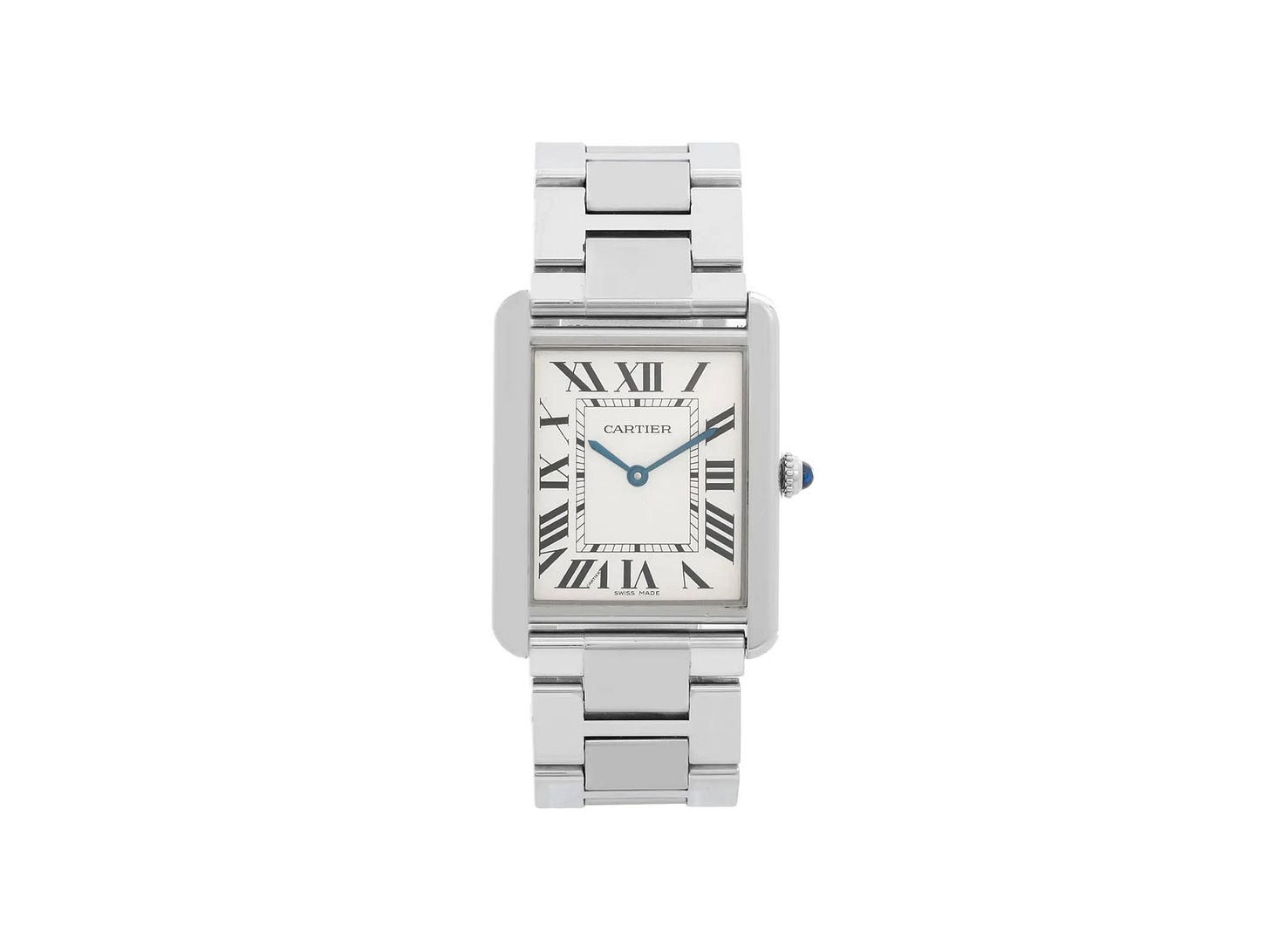
Cartier Stainless Steel Tank Solo Watch (Large Model) Another one of my earlier buys, this was a big deal, a “big girl” purchase—a watch! While I had bought other timepieces before, they were jewelry watches, such as the Tiffany & Co. Atlas on a leather strap and the Hermes Kelly watch, which is more for looks than function. However, this watch made me feel like a boss, and it still does to this day. The coolest detail is the links, by the way. They alternate between polished, matte, polished, matte, and so on. Little touches like this I live for.
Pre-owned Chunky Curb Link Chain Necklace (similar) This chain is like a chameleon, constantly transforming. That’s what makes it extraordinary in my eyes, beyond provenance or any brand name. The versatility is unmatched— it serves as the base of any necklace stack, complementing pearls, diamonds, and everything in between. With a satisfying weight—not too heavy, not hollow—it simply feels great to wear. And that’s what matters most.
Gold-filled Lanyard (similar) This is a recent addition to my collection, but I find myself using it daily (for work). Previously, I carried my loupe, office fob, and penlight on a very official and serious-looking Swiss laboratory lanyard, which didn’t quite match my vibe. This new addition fits my personality and wardrobe much better, by a mile!
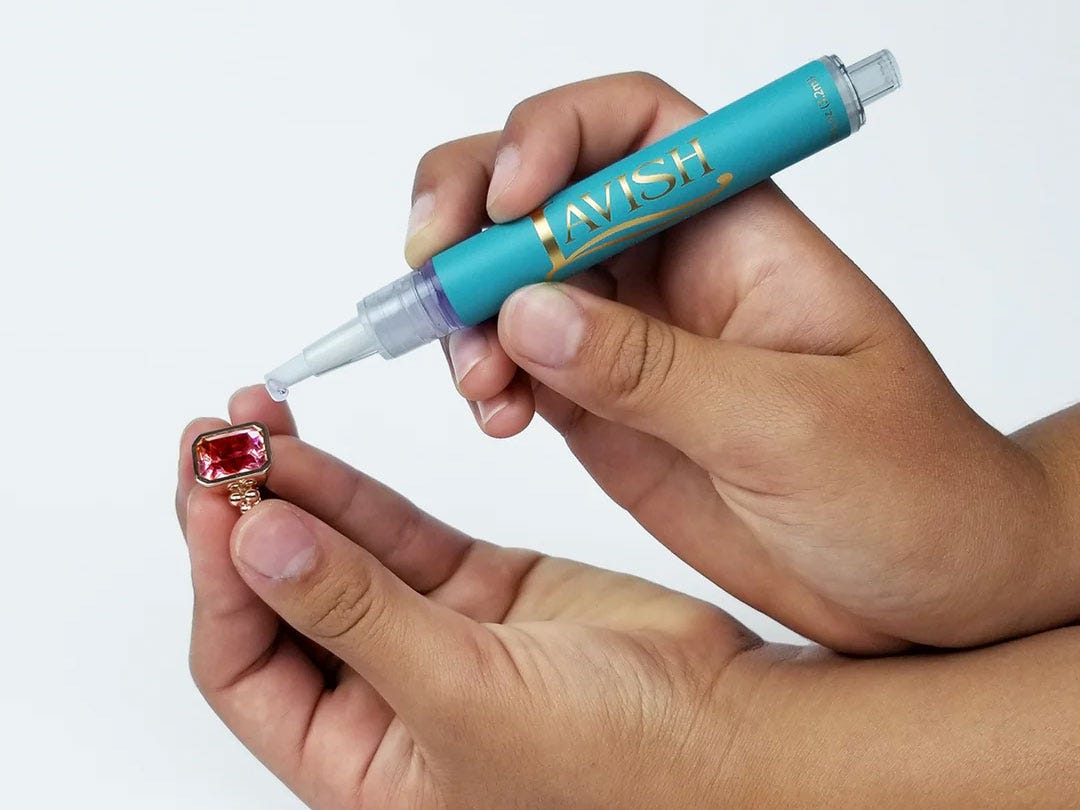
Lavish Click Clean Pen I'm never without my jewelry cleaning pen. Jewelry care is something that people don't think about. We take care of our leather bags and our leather shoes, we take our clothing to the dry cleaner, but we forget about cleaning our jewelry. Be proactive and ask about care protocols, including how often pieces should be cleaned, polished, etc.
During a sabbatical from Instagram, Veronica started reading Substack voraciously and noticed there wasn’t much content for jewelry enthusiasts. Recognizing that the jewelry industry can feel insular and inaccessible to outsiders, she decided to launch her own newsletter, Vejeweled. Through her writing, she aims to have fun, share her knowledge, and inspire others to explore jewelry without feeling intimidated (because it can be intimidating).
How did you end up working in the jewelry industry. Did you always know this is what you wanted to do?
I feel like I've been in this business since I was a baby because I really grew up in the business. I started working for a well-known jewelry buying firm right out of college. I fell into that job and I thought it was cool that it involved jewelry, but I was really clueless about how the industry worked.
I started as a receptionist, fell in love with it and worked my way up by doing every position within that company. I started off as an assistant to the buyers, helping them after they made their purchases or consignments, which was a lot of valuable hands-on training. Then I went on to take formal courses at The Gemological Institute of America (GIA)—such as a diamond grading course and a colored stone course—to get the Graduate Gemologist degree that I have now. This means I can identify gemstones based on their unique properties using tools like microscopes and specialized tests.
I took the initiative to get out there, do a lot of research, get my hands dirty, ask lots of questions, and make friends with all of the dealers in the trade. I did get some formal education, but much of my knowledge came from this boots-on-the-ground approach.
I then moved on to working on the selling side of things— getting an understanding of what happens to jewelry pieces after we buy them and seeing the whole cycle. That's what I loved most— working with secondhand and estate dealers to see where these pieces go, and learning about pricing from sitting and working with them. I really enjoyed pulling back the curtain on that aspect, understanding what makes pieces desirable, why they're desirable, and how value is calculated. Is it purely intrinsic, or is there something more mystifying about it? It's similar to art at auction: why is one piece worth two million dollars, while another is worth only $100,000— simply because someone says so?
That’s where I started to learn about provenance. I took the initiative to get out there, do a lot of research, get my hands dirty, ask lots of questions, and make friends with all of the dealers in the trade. I did get some formal education, but much of my knowledge came from this boots-on-the-ground approach.
I left that buying firm about three years ago because there was sort of a glass ceiling. It was a larger corporation and there wasn’t much room for me to grow, so I moved on to a family-owned gemstone manufacturing business. We specialize in Colombian emeralds directly from the source (I will be visiting the mine in Colombia soon). It's a different world—more gems, less finished jewelry—so I’m seeing another side of the business. I’m developing brands and designers, going to trade shows in Tucson, and managing social media. I'm also still doing some jewelry consulting on the side because that’s my first love.
Can you talk more about pricing second hand jewelry? For someone unfamiliar with the market, what are the key factors to consider?
First, you need to consider intrinsic value— the worth of the raw materials. In precious jewelry made of gold or platinum, that means how much metal is used (how much does it weigh) and its current market value. The price of gold varies from day to day. For example, a Cartier Love bracelet might only have $300-$400 worth of gold, but retails for $6,000 or more. Why? It's Cartier— the brand carries status, and the design itself is iconic.
It is wise for people to do research and get comps from places like auctions. People find auction houses intimidating, but their websites have tons of info, including the results for all of their auctions dating back several years.
Diamonds also have intrinsic value (natural diamonds—not lab-grown, which don't hold resale value). Everyone in the secondhand business uses the Rapaport price sheet. This tells you a diamond's current value based on size, color, and clarity.
It is wise for people to do research and get comps from places like auctions. People find auction houses intimidating, but their websites have tons of info, including the results for all of their auctions dating back several years. You don't want to look at prices from 10 years ago, but if you're thinking of buying an Alhambra necklace, you can see what similar ones sold for recently at auction. That's a good guide for price.
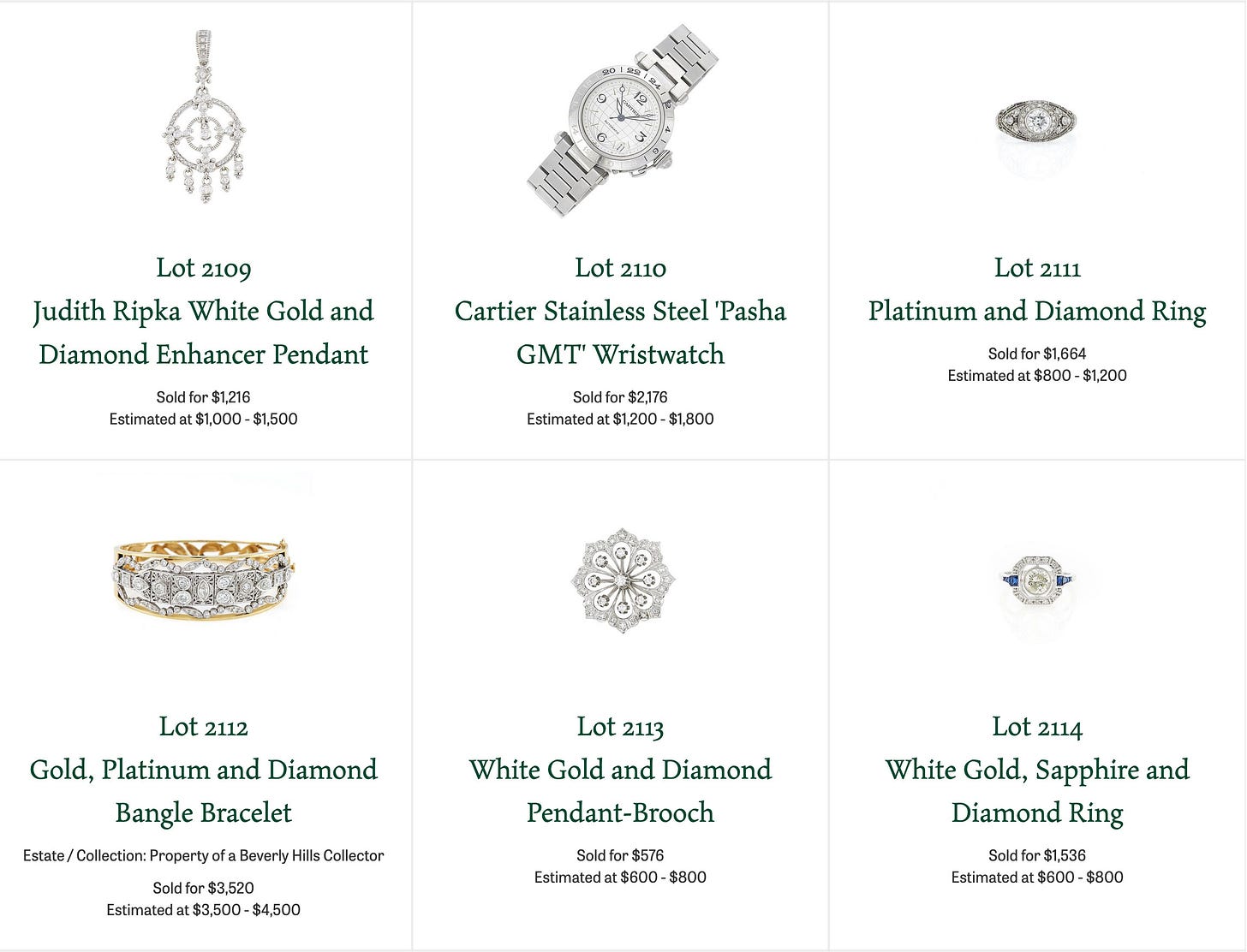
Age adds value— a true Victorian, Georgian, or Art Deco piece is worth more than just its raw materials. Pieces signed by famous makers also fetch a premium. And, obviously, rarity increases intrinsic value.
Gold prices, like any market, fluctuate daily— not dramatically, but by small amounts. Refineries track that closely, but consumers should also be aware of a piece's basic intrinsic value.
When hunting for vintage and secondhand finds, do you have go-to places you love, whether in-person or online?
I've been scouring a site called Ruby Lane— it's fantastic for costume pieces, but they also have fine jewelry. It's still a bit under-the-radar. Coming from my background, I used to be a total snob about costume jewelry— pearls, brooches, anything that wasn't Chanel. But lately, I've been on this real costume jewelry kick. I'm obsessed with 80s and 90s styles, and even found some really cool Napier and Monet pieces from the 60s and 70s.
I love Doyle Auctions here in New York. I would describe them as your friendly neighborhood auction house— super warm, inviting, and with a great selection of curated pieces. They specialize in jewelry, but also offer arts and furniture. I wrote a piece about one of their last auctions, and it also happens that two of my best friends work as specialists there. They're located on the Upper East Side and you can walk right in during open hours and browse anything that catches your eye. Plus, they're very good at walking people through the process. You can also consign jewelry to them or have it evaluated by a specialist before consigning. I’ve been to every auction house in New York and they're one of the most friendly and less intimidating options.
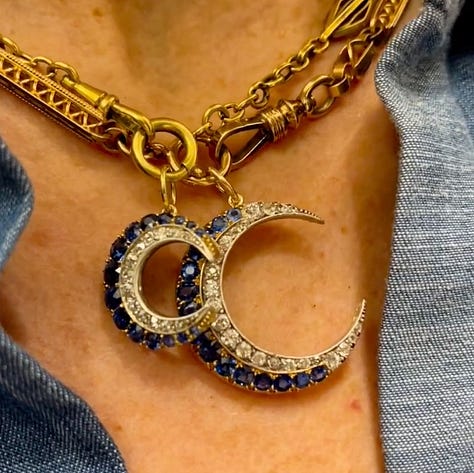
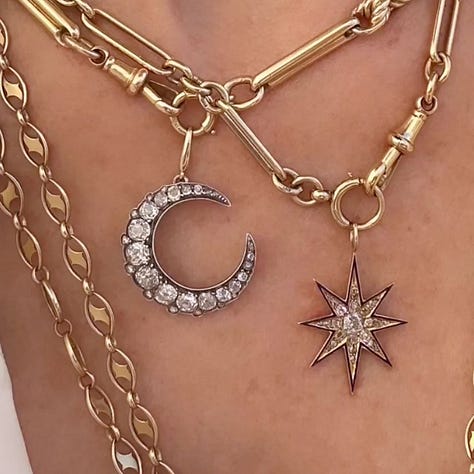
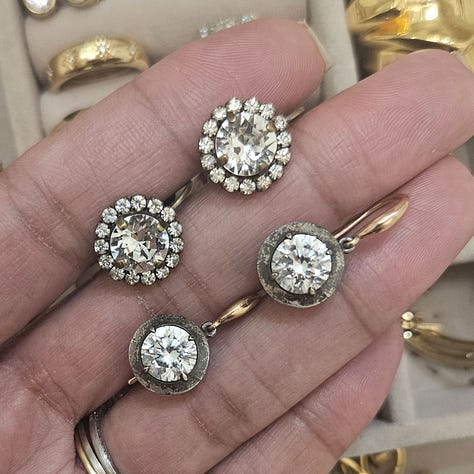
I made a recent discovery at the Manhattan Vintage Show. Her name is Paula, owner of PRCNYC. She curates beautiful Victorian and vintage chains and charms with a keen eye, often sourcing them from Europe— think London and Paris, which have incredible secondhand jewelry markets.
I love Victorian jewelry, especially the use of “paste”, a type of glass that was used as a substitute for gemstones like diamonds, which was popular during that time. However, the price tags associated with original Victorian pieces, especially the exceptional ones, often leave me hesitant. So, I opted for these charming reproductions instead. They capture the Victorian aesthetic perfectly, but I don’t feel the need to be so precious with them. Plus, they’re incredibly versatile for everyday wear. I’ve even worn them in my second hole with a longer dangling earring in the first.
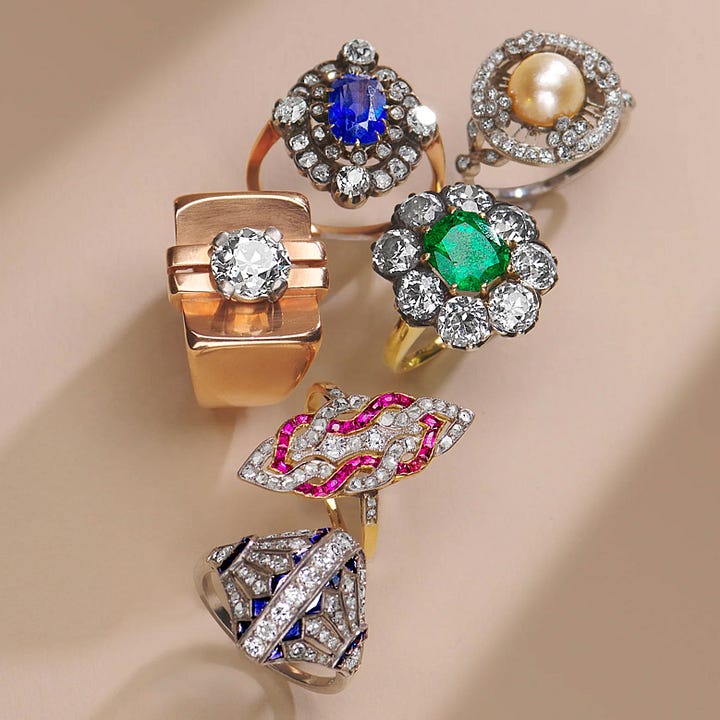
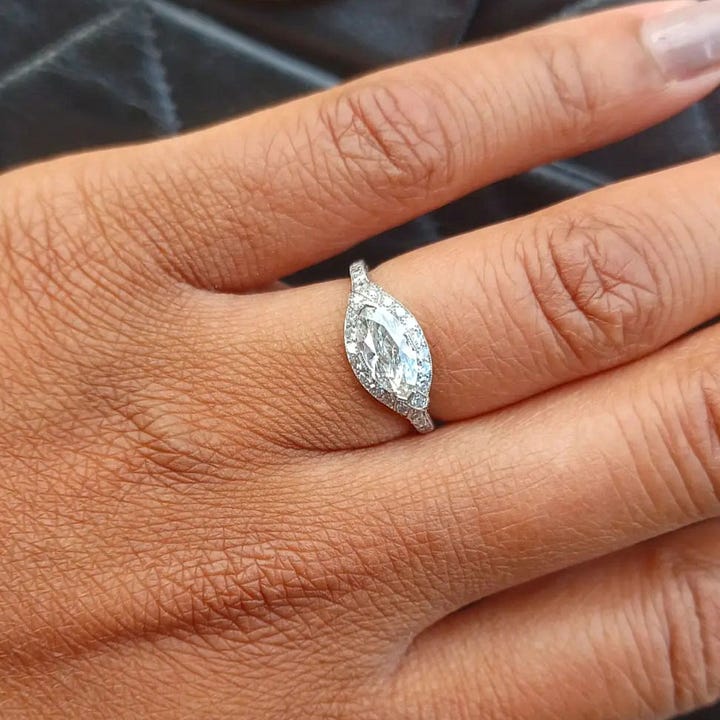
I also often recommend people go to Erstwhile for engagement rings. They created my engagement ring for us, drawing inspiration from an Art Deco ring I once saw made by Tiffany & Co. Three years later, and I’m still as enamored and impressed by it. They’re lovely people and they do really beautiful, unique work and hold your hand through the process. They've got great eyes, and they source really unique and cool stones and will make you just about anything. They also have second hand antique pieces if you're interested in buying something antique.
With lab-grown diamonds and gems gaining so much popularity (e.g. Dorsey), how do you see them fitting into the jewelry world? Is that considered costume jewelry?
Costume jewelry is simply any piece not made from precious metals. I'm familiar with Dorsey and love what they're doing. If their jewelry uses plated silver and lab-grown diamonds, it has virtually no intrinsic value. Silver has some worth, but not compared to gold or platinum. I love the concept and find it fun! However, it's important buyers know they're not purchasing something with long-term value. My goal is to ensure clients understand exactly what they're buying.
I'm all for simulated diamonds [ed note: different from lab grown diamonds]. I wear simulated diamond stud earrings and a simulated diamond tennis bracelet myself. However, I do worry that sometimes there's a lack of transparency in the market. People are buying engagement rings, for example, without understanding that the resale value is very low.
Your career path has taken you from estate jewelry to gemology. How has that influenced your taste?
I'm definitely more open-minded now. Seeing so much jewelry in the past, I admit I was a bit jaded and snobby. Maybe it's age, maybe it's experience, but I appreciate a much broader range of styles now. Five years ago, I would not have worn pearls or brooches, and I didn't have an appreciation for jewelry with gemstones at all.
Now, I'm in awe of anyone setting gemstones because it's not easy, especially with delicate ones like emeralds. Emeralds are beryl, a softer material than diamonds, so you've got to be an extremely skilled setter and really trust the person setting the emeralds in order not to damage them.
I'm also getting exposure to modern contemporary designers now, which wasn't the case before. That's become a large part of what I do.
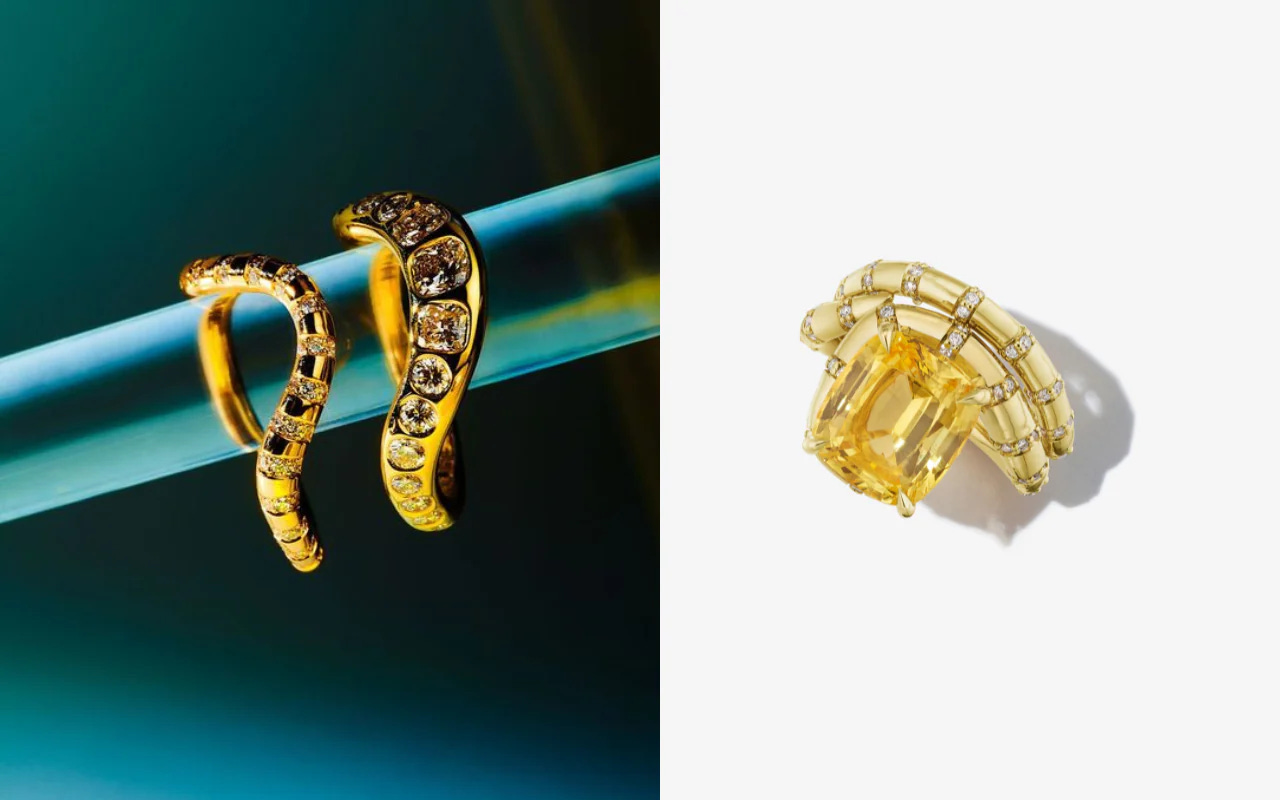
Are there any contemporary jewelry designers that you like and think more people should know about?
I want people to know about Darius Jewels. She's a California-based designer doing amazing work with high-carat gold and a very wearable, Old-World-inspired aesthetic. She uses both diamonds and colored stones. Uniform Object is another favorite— David creates these very cool, very wearable pieces that would fit into anyone's collection. I also love Sarah Dyne—she's truly an artist, her Instagram shows her incredible artistry. Her stone setting is so unique and edgy—I don't see anyone else setting stones the way she does. Plus, she's making these fantastic ear cuffs that fit perfectly and she incorporates stretches of diamond, emerald, or sapphire baguettes, which is really unique.
Thank you, Veronica! This was so interesting to get a peek into the industry and I’m in awe of so many of the beautiful pieces you shared. I'm also obsessed with looking at all of these past auction results— I guess it’s my new hobby 💎.
Subscribe to Veronica’s newsletter
and check out some of her recent posts for much more jewelry goodness:Let us know if you have any questions for Veronica in the comments. And if you know anyone who might be interested, please pass this along to them.
If you have your own favorite jewelry or places to find it, I’d love to hear it! Share in a comment below or hit reply to send me a note.






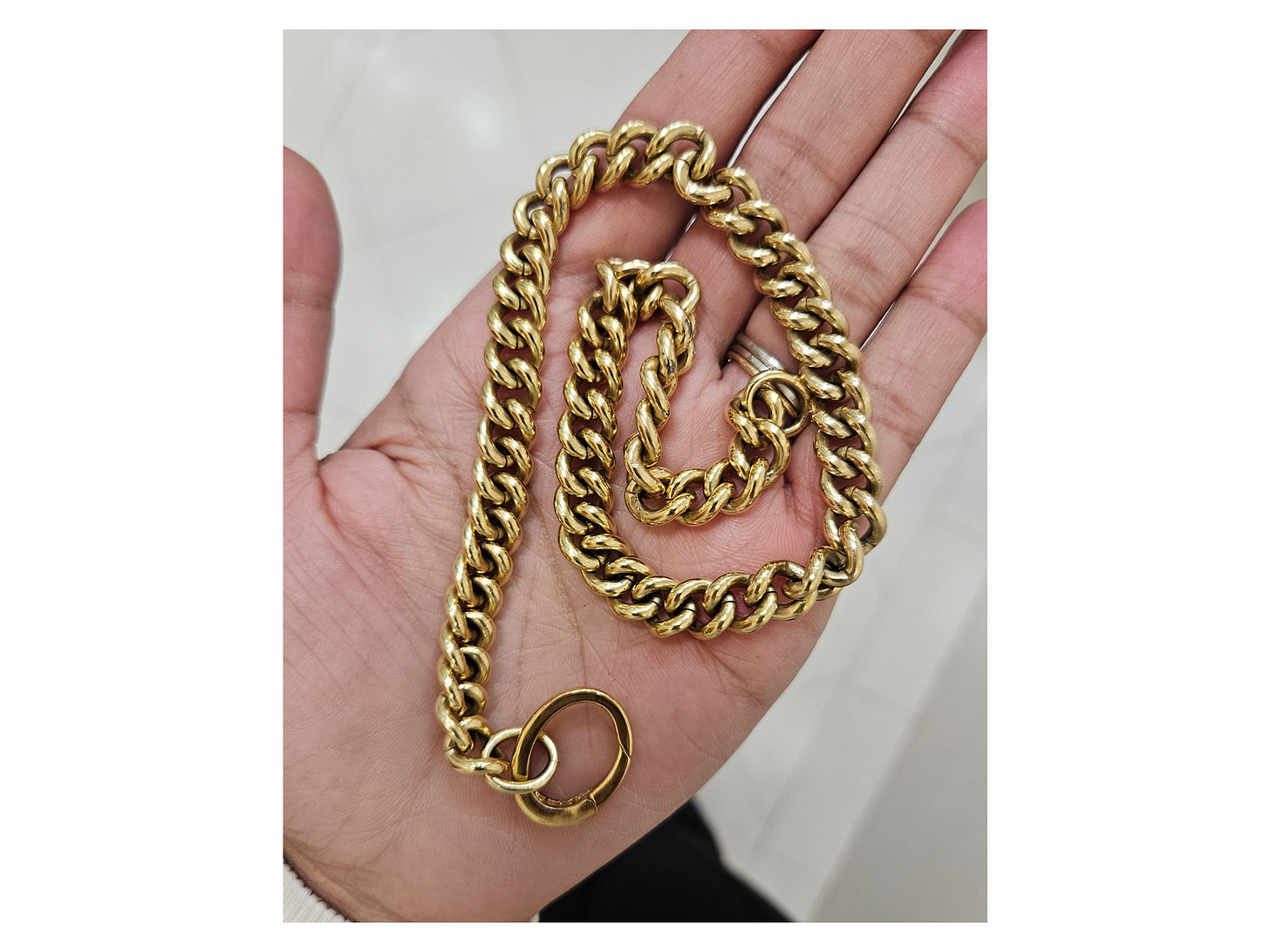
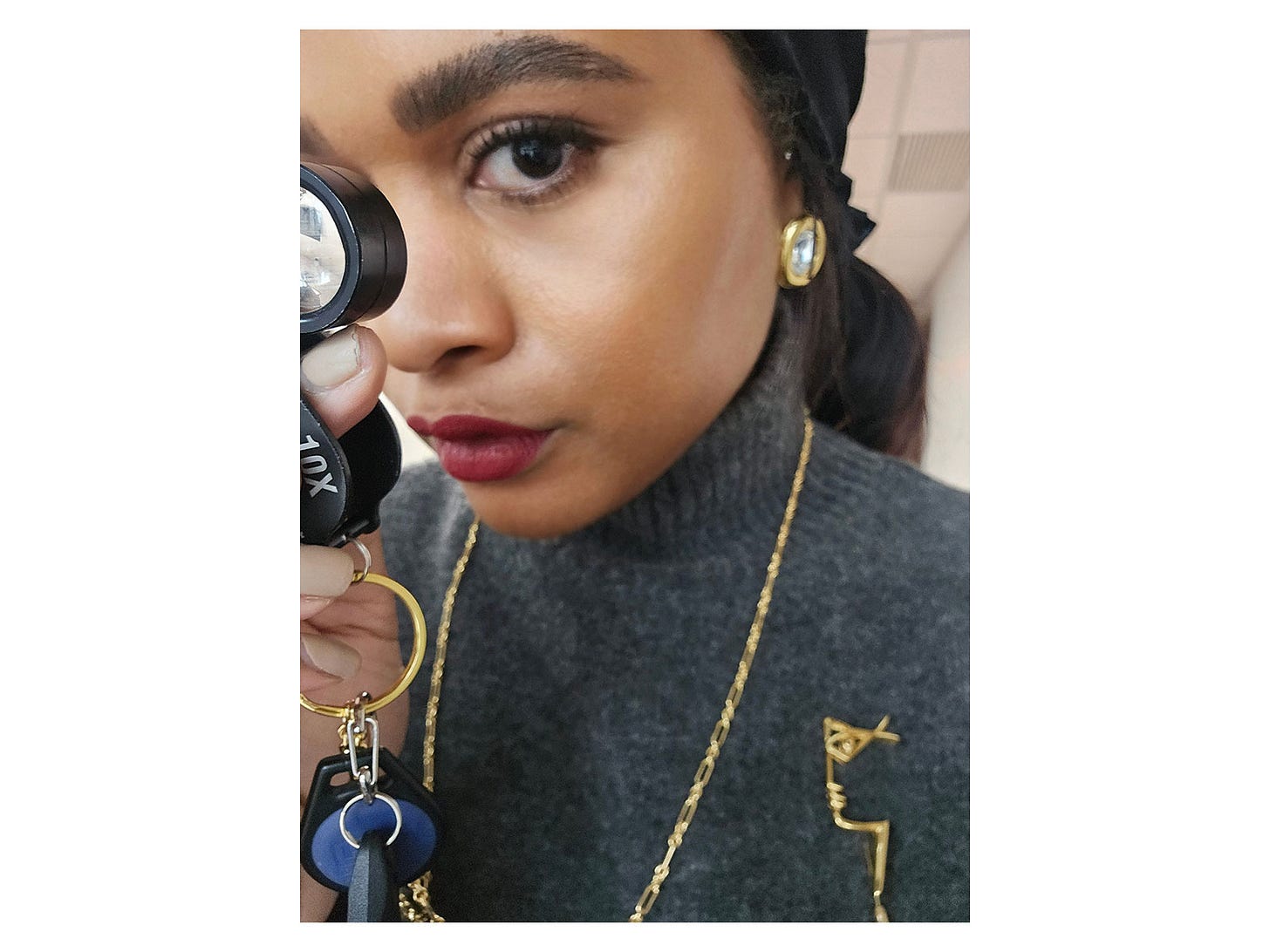
What a read! I love that Veronica states the truth here about the intrinsic value of simulated diamonds and plated metal jewellery - I just don’t think people are aware enough! Saving for one really good, solid gold piece over lots of expensive costume jewellery has always been my thought…go high or stay very low. Never the middle!
What a fascinating career journey and I can only imagine that she will keep trailblazing forward with her skillset xx
What a fantastic read. Thank you so much. So interesting… also: 😍engagement ring😍